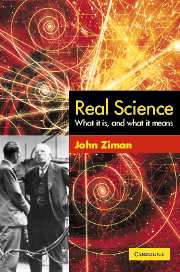Book contents
- Frontmatter
- Contents
- Preface
- 1 A peculiar institution
- 2 Basically, it's purely academic
- 3 Academic science
- 4 New modes of knowledge production
- 5 Community and communication
- 6 Universalism and unification
- 7 Disinterestedness and objectivity
- 8 Originality and novelty
- 9 Scepticism and the growth of knowledge
- 10 What, then, can we believe?
- Endnotes
- Bibliography and author index
- Index
5 - Community and communication
Published online by Cambridge University Press: 24 August 2009
- Frontmatter
- Contents
- Preface
- 1 A peculiar institution
- 2 Basically, it's purely academic
- 3 Academic science
- 4 New modes of knowledge production
- 5 Community and communication
- 6 Universalism and unification
- 7 Disinterestedness and objectivity
- 8 Originality and novelty
- 9 Scepticism and the growth of knowledge
- 10 What, then, can we believe?
- Endnotes
- Bibliography and author index
- Index
Summary
What sort of knowledge?
The function of science is to produce knowledge. What sort of knowledge does it produce? Until recently, this question was supposed to be essentially ‘philosophical’. Unfortunately [ch.1], the philosophers of science have not come up with a convincing answer. In spite of heroic efforts, they have simply failed to come up with a satisfactory definition of ‘science’.
In practice, however, most educated people agree that certain bodies of knowledge are, indeed, peculiarly ‘scientific’. They do this on the basis of a number of characteristic features, many of which lie outside the scope of conventional philosophical analysis. Indeed, as every would-be meta-scientist soon discovers, the ‘philosophy’ of any serious scientific discipline is so wrapped up in its subject matter that it cannot be accounted for historically or analysed without a good grasp of its technical language. Since nobody really knows all these different languages, people have to rely on what they know of the social origins of the knowledge in question. In default of better criteria, they put their trust in ‘scientists’, as individuals and as an organized group, to produce genuinely ‘scientific’ knowledge.
This reasoning is, of course, incorrigibly circular. But remember that we are adopting a naturalistic stance. If the entity that people identify as science has distinctive social characteristics, then it is our job to identify these and analyse them. In previous chapters, therefore, we have portrayed science as a social institution, of which ‘academic science’ [2.8] is the ideal type. We have focussed on its practices and norms, showing how these fit together into a distinctive culture [ch.3], and how they are changing in response to various internal and external influences [ch.4].
- Type
- Chapter
- Information
- Real ScienceWhat it Is and What it Means, pp. 83 - 116Publisher: Cambridge University PressPrint publication year: 2000



